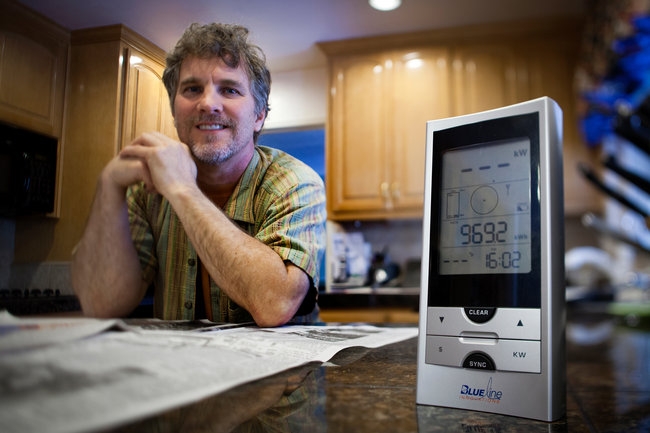
When Max Dunn walks through his kitchen in San Jose, Calif., he often glances at the home energy monitor that sits on the countertop. The monitor resembles a car’s GPS device and connects wirelessly to the home’s power meter.
When Max Dunn walks through his kitchen in San Jose, Calif., he often glances at the home energy monitor that sits on the countertop. The monitor resembles a car’s GPS device and connects wirelessly to the home’s power meter.
 |
| By spending $149 on the monitor and just a few minutes a day checking it and turning things off or down, Max Dunn has consistently reduced his electricity use, he says - in some months, by up to 30% |
The display tells him at any given moment how much electricity the house is using, and on a recent afternoon, the reading was higher than usual for that time of day. So he turned off a home computer that no one was using and the lights in an unoccupied room.
By spending $149 on the monitor and just a few minutes a day checking it and turning things off or down, he has consistently reduced his electricity use, he says — in some months, by up to 30 percent.
Mr. Dunn, who works as a software consultant in Silicon Valley, is what marketing executives call an early adopter, someone who is quick to embrace new technology ahead of the mainstream.
Still, according to Parks Associates, a consumer research firm, about 60 percent of homes will have some form of home energy management network by 2022. This is good news for the companies that make these devices and the retailers who sell them. But are Mr. Dunn’s results a statistical outlier, or will all this technology help significantly reduce the power our homes consume and the dollars we spend?
Savings are possible, according to recent research, as long as the technology is easy for the average consumer to use, and clearly shows which actions can reduce consumption.
“Simply making energy usage visible can have an impact,” said Dan Yates, chief executive of Opower, a company that provides monthly home-energy reports to about 11 million households across the country on behalf of local utility companies. The report compares the home’s energy consumption with previous months, compares it with neighboring homes, and offers tips on saving energy like replacing inefficient light bulbs or taking shorter showers.
Those 11 million households that received the reports averaged annual energy savings of 2 to 3 percent, enough energy to power a city the size of Orlando for a year, according to company-sponsored research. According to that research, the results were consistent among various demographic groups and whether the motivation was saving money or saving the planet.
“Bottom line is people don’t like to waste,” said Mr. Yates, “especially when you show them their usage compared to norms, like similar homes in the neighborhood.”
Getting immediate feedback from an in-home display like Mr. Dunn’s, rather than a monthly mailer, can increase these savings, according to research by the American Council for an Energy-Efficient Economy, a nonprofit research and educational group.
The group recently analyzed results from several pilot programs, most of them utility-sponsored, in which homeowners used monitors to track their energy consumption. Participants in these pilots reduced their energy bills by an average of 4 percent, with those in the most successful program saving close to 20 percent.
Ben Foster, a senior analyst at the council, said the programs that provided the best results did a better job of engaging the customer, and that “engagement seems to be enabled by the types of information provided by the device.” For example, customers were more engaged, he said, when they could learn from the device how their homes used energy and whether their conservation efforts were having an effect.
Understanding how people will use the feedback is the goal of a pilot program just introduced by Pacific Gas & Electric, the utility that serves most of Northern California.
In March, the company began installing energy monitors with 500 volunteer homeowners. The monitor pulls current use data from the power meter every 20 seconds. The display offers a set of gauges similar to a car’s dashboard.
A so-called speedometer shows how much electricity the home is using at that moment. When the speedometer needle moves into the red zone, the home is close to its peak levels in relation to the previous 30-day period. Another gauge shows the current price of the electricity, and it will change colors when the amount of use puts the home into a higher-priced tier.
“Energy usage data is complex,” said Steve Malnight, the company’s vice president for customer energy solutions. “But when you see it on the speedometer and can judge if it’s too high, especially when the price is higher, you can take action like turning off lights or turning down the air-conditioner.”
Using these types of monitors will be voluntary for homeowners, said Mr. Malnight, but he said he expected the technologies to play a crucial role in the utility’s conservation efforts.
“Only when you are aware can you take action,” Mr. Malnight said, “and any time you can shorten the loop between taking action and getting feedback, you will see better results.”
(Source: NYTimes)





